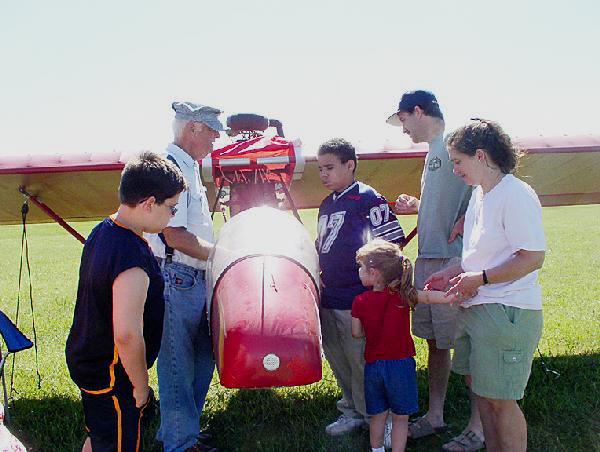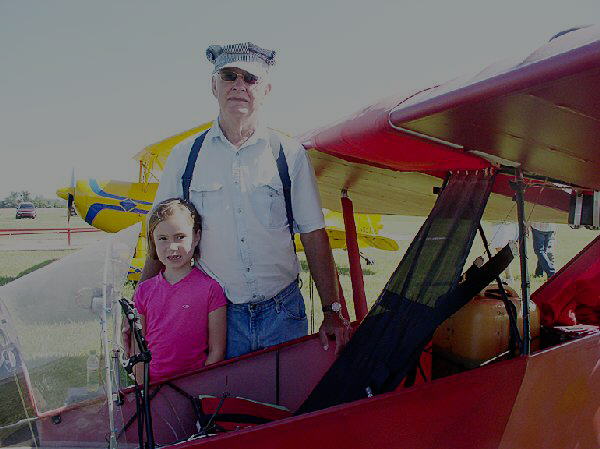|
|
|
One visitor was a woman armed with a camera, a pencil and a pad of paper, who asked a million questions. The following is an article she published in THE NEWS GAZETTE, published in Winchester, Indiana on June 19, 2008. |

By CYNTHIA AUKERMAN Jack Hart's Kolb Firefly looks like an overgrown kite, but it takes him to high places. An ultra-light that he built from a kit, the experimental aircraft doesn't go fast or far but it does get him up into the skies. "It was a terror to fly at first," Hart says. "But it's a pussycat now." The reason Hart's "plane" is a pussycat now is because he's been tinkering with it since he built it in 1999. It's on its second engine, and a third one is in his garage awaiting installation The second engine gave him more traveling time by using fuel more efficiently. He gained about 1 1/2 gallons per hour with the second engine, an Italian model. Two gallons an hour translates into 55 miles per hour. The ultra-light carries only five gallons of fuel, and Hart is always trying to make it go further. He has flown his rig to Hagerstown for chapter meetings of the Experimental Aircraft Association and to Connersville and Marion for fly-ins. "I like to put pins in the map," Hart says about his traveling goals. "I'm not interested in going fast. I'm just interested in getting in the sky." The view from up there in the ultra-light is incredible. The pilot is not enclosed, as in a normal small plane. He can feel the wind in his face and smell the earth. Maybe it's sort of like riding a motorcycle, only at 3,000 feet in altitude. See FLYING, page 9 |
 Jack Hart is shown with his grandaughter, Riley Helms, and his Kolb Firefly at the Randolph County Fly-in. Hart enjoys talking to children about flying, and he encourages them to realize they can do whatever they set their minds to. The ultra-light weighs only 252 pounds, but it can carry Hart high into the sky. Made of dacron, the ultra-light can fold up for storage.
Jack Hart is shown with his grandaughter, Riley Helms, and his Kolb Firefly at the Randolph County Fly-in. Hart enjoys talking to children about flying, and he encourages them to realize they can do whatever they set their minds to. The ultra-light weighs only 252 pounds, but it can carry Hart high into the sky. Made of dacron, the ultra-light can fold up for storage.
Retired from RCA as a member of its equipment development group, Hart and his wife moved to Randolph County when his daughter, Elizabeth Helms, moved here. He calls himself a "lifelong student pilot," which means, yes, he has taken plenty of flying lessons, but no, he never got his pilot's license. He has a lot of hours in the air, but something always came up to prevent him from taking the final steps for licensure. Flying an ultra-light does not require a pilot's license, but it surely requires a pilot's skills. Flying an ultra-light is NOT easier than flying a "real" plane. Hart says, "You can kill yourself in one of these just as quick as in a regular plane." So just how does a person fly an ultra-light for the first time? Very carefully, in Hart's case. He hadn't flow in 10 years or more. He took his plane out to the airport for lots of practice in taxiing. "It's your legs that forget about flying first," he explains. After practicing, first in calm air, then in crosswinds, he found a fella to check him out on the ultra-light. After two hours, the coach told him he was ready to go. Hart remembers, "That first flight wasn't fun. But it's been worth it." The most vulnerable time in the ultra-light is at take off and landing. "If you have the altitude, you can handle anything, even spinning around," Hart explains. The spinning around can happen when the ultra-light hits a clear air dust devil (eddy) that suddenly causes the ultra-light pilot to be facing opposite the direction he was headed. "It's no big deal," Hart asserts. "But at 2,000 or 3,000 feet, it's pretty smooth up there, no matter what's happening on the ground." Of course, altitude can have its drawbacks. Hart says the thought occurred to him that he could fall out of his plane. So he got a better seatbelt to replace the racing buckle he first had. He saw just what he needed at Toys R Us, and the new seatbelt even saved him a couple of pounds. "You have to be part of the plane," he says. "It's almost like you're wearing the plane. You have to be able to move with the plane when it dances all over." Still, an ultra-light that flies has to take off and land, and that's the tricky part. He can handle a 15 mph crosswind while landing - a 20 mph crosswind is tougher but doable. Hart admits, "The last 1,000 feet can keep you pretty busy. You have to keep your wings level, and slow down but not too far down." The ultra-light has the advantage of not having a long fuselage that can catch the wind. Hart's fuselage is a long tail pipe. The body of the ultra-light is made out of dacron material, just like a woman's slip. He used an iron to put the material on the frame. He swears the material is "super strong." To qualify as an ultra-light, the plane can't weigh more than 254 pounds. To keep the weight down, Hart attaches his radio to one leg and the GPS to another leg. The two items are plugged into his plane, but because they aren't part of the plane, they don't county towards the weight limit. Hart isn't finished tinkering with his plane yet. For an engineer, tinkering is a good part of the fun of having an ultra-light. "This engine runs sweet, but it is way too powerful," Hart says. "The new one will allow me to cut the weight even further." For more information about ultra-lights, go to the website where those who build and fly them trade solutions and knowledge: http://www.thirdshift.com/jack/firefly/firefly.html. |